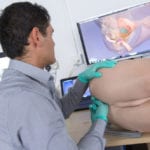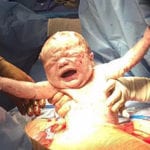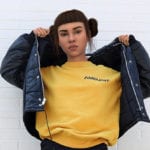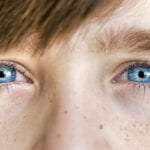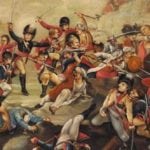 Our World
Our World  Our World
Our World  Movies and TV
Movies and TV The 10 Coolest Stars to Set Sail on The Love Boat
 History
History 10 Things You Didn’t Know About the American National Anthem
 Technology
Technology Top 10 Everyday Tech Buzzwords That Hide a Darker Past
 Humans
Humans 10 Everyday Human Behaviors That Are Actually Survival Instincts
 Animals
Animals 10 Animals That Humiliated and Harmed Historical Leaders
 History
History 10 Most Influential Protests in Modern History
 Creepy
Creepy 10 More Representations of Death from Myth, Legend, and Folktale
 Technology
Technology 10 Scientific Breakthroughs of 2025 That’ll Change Everything
 Our World
Our World 10 Ways Icelandic Culture Makes Other Countries Look Boring
 Our World
Our World 10 Ways Your Christmas Tree Is More Lit Than You Think
 Movies and TV
Movies and TV The 10 Coolest Stars to Set Sail on The Love Boat
 History
History 10 Things You Didn’t Know About the American National Anthem
Who's Behind Listverse?

Jamie Frater
Head Editor
Jamie founded Listverse due to an insatiable desire to share fascinating, obscure, and bizarre facts. He has been a guest speaker on numerous national radio and television stations and is a five time published author.
More About Us Technology
Technology Top 10 Everyday Tech Buzzwords That Hide a Darker Past
 Humans
Humans 10 Everyday Human Behaviors That Are Actually Survival Instincts
 Animals
Animals 10 Animals That Humiliated and Harmed Historical Leaders
 History
History 10 Most Influential Protests in Modern History
 Creepy
Creepy 10 More Representations of Death from Myth, Legend, and Folktale
 Technology
Technology 10 Scientific Breakthroughs of 2025 That’ll Change Everything
 Our World
Our World 10 Ways Icelandic Culture Makes Other Countries Look Boring
10 Weird Examples Of Pseudoscientific Technology
We are surrounded by devices that work according to well-understood scientific principles. However, there are lost avenues of scientific inquiry, products of muddled or magical thinking, with an engineering bent that have created a number of wondrous machines that don’t necessarily have to conform to the boring old laws of physics.
10 Electromechanical Random Number Generators

When people seriously believed that psychic powers could be scientifically quantified in experimental conditions, a lot of effort went into developing techniques by which such powers could theoretically be measured. It had to be guaranteed that experimental subjects wouldn’t be able to predict or calculate the results of a test in mundane ways. Simple experiments using Zener cards and the like were criticized as being relatively easy to fool with non-ESP techniques like card counting and also as being subject to flaws like imperfect shuffling. Parapsychologists also worried that other forms of psychic powers, like mind-reading or telekinesis, could be used to obscure the results of an ESP experiment.
Computer-generated random number tables were used for a time, the most popular being the Rand Table of a Million Random Digits, but they fell out of favor. Another technique involved a 10-sided die being rolled 12 times to create four three-digit numbers. The first number was then multiplied by the second, the product was multiplied by the third, that product was multiplied by the fourth, and finally, the last product was multiplied backward by itself. Though the method wasn’t considered foolproof, many saw it as adequate.
Randomization techniques took a quantum leap in the 1970s with the development of electromagnetic random number generators, which could be interfaced with other devices to acquire, store, and retrieve data. They used natural sources of randomness, usually a radioactive core of strontium-60 or Ziner diodes, which produced a fluctuating electromagnetic field. This field could be used to have a randomized effect on an electromechanical system like an alternating flip-flip circuit, leading to a random result that would be impervious to all mundane forms of fraud or non-psychic technique. Admittedly, at the time, some worried that there was no way to know whether or not a form of “super-psi” in the hands of the experimental subject or the researcher could obscure the results of the experiment.
9 Spiricom
Starting in the 1970s, retired engineer George Meek embarked on a quest to develop technology to communicate with the dead, having been inspired by the “discovery” of electronic voice phenomena, through which people claimed that spirits could communicate via radio technology. Meek believed that the physical world was connected with layered spiritual realms—the lower, middle, and higher astral planes, followed by the mental and causal level, and finally the celestial plane. Each plane of existence, he reasoned, had its own resonant frequency which could be accessed with radio technology.
From 1979, he worked with medium Bill O’Neil to develop a device called the Spiricom (short for spirit communication), which was equipped with 13 tone generators that were said to span the frequency range of an adult male voice. This was combined with a 29-megahertz AM transmitter and receiver fed into a speaker, all held within a Faraday cage to prevent outside interference. A cassette recorder was placed across the room to capture the voices of spirits that were allegedly able to modulate the radio frequencies in a way that mimicked vocal audio. Both O’Neil and the spirits communicated in a strange buzzing fashion.
The device was said to have been built with technical advice from deceased NASA scientist George Mueller, who had communicated with Meek during a seance. O’Neil was also in contact with a spirit who called himself “Dr. Nick” and claimed to have been a ham radio enthusiast in life, and several other spirits apparently turned up as well. O’Neill recorded 20 hours of communications with Dr. Mueller, despite some occasional technical confusion and interruptions by other spirits. The transcript of one dialog goes as follows:
Doc Mueller: William, I think that’s much better. Right there, William. Now, William, did you understand? Williammmmmm?
Bill O’Neil: Yes sir, I understand Doctor.
Doc Mueller: Very well, I will hive you a count from one to ten. One, two, three-four-five-six-seven-eight-nine, ten. One moment, William.
Bill O’Neil: Okay.
Doc Mueller: Very well, then. Mary had a little lamb, its fleece was white as snow. And everywhere that Mary went the lamb would goooooo. Goooooo. Play that back for me, William. [Pause] William?
Bill O’Neil: Yes, sir?
Doc Mueller: Play that back for me.
Bill O’Neil: All right, Doctor. I am sorry, I was lighting a cigarette.
Doc Mueller: Oh, those cigarettes again!
The design for the Spiricom was later made publicly available for anyone to build themselves. Modern miniaturized versions have been developed using cheaper modern FM transmitters and CD-ROM recordings. No one has had the same success with the Spiricom device as Meek and O’Neil. Believers claim that this is because only an individual with particular psychic skills is able to successfully operate the device.
8 God Helmet
This device was originally known as the “Koren Helmet,” having been designed by Stan Koren and Michael A. Persinger of Laurentian University. The device purports to be able to stimulate religious feeling in the human brain by generating weak magnetic fields (though these fields are only about as strong as those of a landline telephone or hair dryer). The God Helmet, as it was dubbed by journalists, is a converted skin helmet fitted with solenoids that connect to the cranium by electrodes, which Persinger claims alters the electromagnetic field in the temporal lobes. The left temporal lobe interprets this activity as a sensed presence, which may be perceived by the user as the presence of God or even demons. It is also said to have produced visions of other worlds and astral projection, as well as producing feelings of euphoria, anxiety, fear, and sexual arousal.
According to Persinger:
Thus far, about 20 or so people have reported feeling the presence of Christ or even seeing him in the [experimental chamber]. Most of these people used Christ and God interchangeably. Most of these individuals were older and religious. One male, age about 35 years old (alleged atheist but early childhood Roman Catholic training), saw a clear apparition of Christ staring him in the face. He was quite “shaken” by the experience. I did not complete a follow-up re: his change in behavior. Of course these are all reports. What we did find with one world-class psychic who experiences Christ as a component of his abilities was we could experimentally increase or decrease his numbers of his reported experiences by applying the LTP pattern (derived from the hippocampus) over the right hemisphere (without his awareness). The field on-response delay was about 10 to 20 sec. The optimal pattern, at least for this person, looked very “right hippocampal.” By far most presences are attributed to dead relatives, the Great Forces, a spirit, or something equivalent.
Persinger believes that religious experience may be caused by natural forms of electromagnetism like weather conditions or meteor showers. When noted skeptic Richard Dawkins tried out the helmet, he reported feeling disappointed he did not come into contact with God, reporting only somatic sensations in his breathing and limbs. A Swedish study failed to replicate the same effects and concluded that the earlier results may have been due to suggestibility and sensory deprivation as much as anything else.
A variation of the helmet was used by the doomsday cult Aum Shinrikyo. They claimed that the electrodes could help connect the user to the brainwaves of their messiah figure, Shoko Asahara. This was a necessary part of their “Perfect Salvation Initiation” ritual and cost users one million yen a month.
7 ASCID

Researcher Jean Houston and her husband, Robert Masters, have developed a device that uses movement in three dimensions to induce a trance state. It’s believed to have been based on the concept of the medieval “witch’s cradle,” used to enhance fantasy and alter consciousness, though it was possibly also a torture device. They called it the “Altered States of Consciousness Induction Device,” or ASCID. It combined sensory deprivation with a free-moving support system to confound spatial awareness and kinesthetic cues. It was alleged to cause visual and auditory hallucinations with a dream-like quality, often with mystical, religious, or science-fiction themes, as well as the subjective distortion of time.
The device is described somewhat obliquely by one source:
It is essentially a metal swing or pendulum in which the subject stands upright, supported by broad bands of canvas and wearing blindfold goggles. The device containing the subject moves from side to side, forward and backward, and rotating motions generated by the subject’s body. Typically, in from two minutes to twenty, an altered state of consciousness or trance state results. Trance depth ranges from light to profound sonambulistic, but in almost all cases the subject experiences vivid eidetic imagery, imagery in other sense modalities, and other phenomena characteristic of trance and psychedelic drug states. The trance is different from a hypnotic trance especially in that the usual hypnotist-subject relationship does not pertain and the experience of the subject occurs with a high degree of autonomy and spontaneity—he goes, if you will, on his own trip.
Use of the device was eventually discontinued by Houston and Master due to people allegedly misusing it out of an addiction to the experience. Houston said, “People would get addicted to it and even refuse to explore their inner states without first taking a ride.”
6 Energy Polarizer
In the mid-1980s, Australian racing legend Peter Brock was trying to deal with the aftermath of a Porsche crash at a Le Mans event which had killed a flag marshal. Through his third wife, Bev, he came under the influence of chiropractor, channeler, and guru Eric Dowker, who exorcised the spirit of the flag marshal from Brock and gave him some lifestyle change advice involving vegetarianism, exercise, and energy crystals.
At the time, Brock was looking for new ideas for cars as part of his HDT Special Vehicles contract with car manufacturer Holden and asked Dowker for some advice. The result was a plastic box containing magnets, crystals, and unattached wires fixed with resin called an Energy Polarizer, which Brock claimed would align the molecules in the car and help it to run faster and smoother. The concept was based on the pseudoscience of Orgone energy, first developed by William Reich in the 1930s.
While Holden and most engineers dismissed the device as worthless, Brock was convinced it worked, even claiming that the technology needed to test it had not yet been invented and that a full scientific validation would cost $75,000. The spat between the company and the driver eventually reached an impasse when the company declared that it would not sanction a car built with the Polarizer, and Brock refused to remove it. Brock lost control of HDT and spent the next decade of his racing career in BMWs and Fords. In 2011, duplicates of the Energy Polarizer were included in a limited edition line of cars manufactured in honor of Brock.
5 Kozyrev Mirrors
Russian astrophysicist Nikolai Kozyrev developed a number of unusual theories that may have been influenced by Russian cosmism and don’t seem to correlate with our scientific understanding of the universe. Kozyrev believed in the existence of a “torsional energy field” beyond electromagnetics and gravity, which travels faster than the speed of light. He called it the “flow of time.”
He wrote, “Time is the most important and most enigmatic property of nature. Time is not propagated like light waves; it appears immediately everywhere. The altered properties of a certain second of time will appear instantly everywhere at once, just as time is everywhere. Time links us all and all things in the universe.”
Kozyrev also believed that the density of time varied, becoming denser near the receiver of an action and thinner near the sender, a difference which he could detect with instruments like gyroscopes, asymmetrical pendulums, and torsion balances. Variations in time density were the force that lay behind psychokinesis and other psychic powers like telepathy. He also believed that the density of time was affected by the weather, seasons, biological growth, gravity, and the density of matter. He claimed that time density remained longer in certain materials, particularly aluminum, which he held to be an excellent shielder and reflector of time.
Following Kozyrev’s death, others continued to explore his research in the early 1990s. Researchers V.P. Kaznacheev and A.V. Trofimov built rooms lined with aluminum mirrors to conduct telepathy experiments with images, which they claimed increased the accuracy rate by three to six times. It was theorized that the mirror arrays helped to increase the focus of the torsion waves or “time.” During long-distance testing, it was reported that disc-like light effects appeared in the night sky.
Some claim that the Kozyrev mirrors create a closed space, which weakens the magnetic effect of the Earth and opens up human access to solar and galactic information. Supposedly, the Institute for Scientific Research in Cosmic Anthropoecology (ISRICA) has used the mirrors to engage in energy-flow seances designed to help people become interstellar mediators for the Galactic Community.
4 AMI Device

When Japanese scientist Dr. Hiroshi Motoyama’s health declined after the age of 45, he took up yoga and claimed to have experienced an influx of ki energy into his body. Eager to prove it to skeptical colleagues, he attempted to measure ki with EEG and ECG scans but wasn’t satisfied with the results. So, he developed the Apparatus for Meridian Identification (AMI), aka the Life Energy Analyzer, advertised as a device “for measuring the functioning of the Meridians and their corresponding Internal organs.”
The AMI measures the electrical conductivity, capacitance, and polarization of skin tissue and fluids at specific acupuncture points at the tips of the fingers and toes (known as Sei points or Jing/Well points) and uses those measurements to produce data on the tissue’s condition and the functioning of acupuncture meridians. This data purports to show the condition of the meridians and functioning of the organs corresponding with those meridians (lung, large intestine, heart, small intestine, spleen, liver, stomach, urinary bladder, kidney, and gallbladder), determine whether the levels of ki energy in the body are too high or too low, monitor the effect of acupuncture, meditation, and exercise on ki energy, and also determine which of the body’s chakras are active at any one time.
Motoyama’s device has been used to test ESP abilities in people, based on the hypothesis that people with normal or excessive levels of ki energy will perform better on ESP tests. Motoyama also indicated that certain meridians were of greater importance to ESP research than others, claiming that ESP abilities are linked with excesses or deficiencies in the meridians associated with the gastric, spleen-pancreas, and triple heater functions. No correlation was found between ki levels and ESP ability, though there was apparently a high correlation between meridian activity related to the gastric system and extrasensory perception.
3 Psychotronic Generators
In the 1970s, the United States Defense Intelligence Agency became alarmed at reports coming out of Czechoslovakia and the rest of the Soviet bloc which seemed to indicate that the West was falling behind in the race to control psychic technology. According to documents released under the Freedom of Information Act, the DIA worried that “if the Soviet reports are even partly true, and if mind-to-mind transference can be used for such applications as interplanetary communications or the guiding of interplanetary spacecraft, the Soviets have accomplished a scientific breakthrough of tremendous significance.”
One of the key individuals believed to have been involved with the research was Czech parapsychologist Robert Pavlita, who developed devices called psychotronic generators.
He was said to have been the lead designer at a textile plant, and he’d patented a new process that gave him enough income in royalties to spend his time poring over ancient alchemical manuscripts in a search of the esoteric knowledge to allow him to build his devices.
They varied in appearance, with some looking like steel rings, others like wooden cabinets, and many others resembling intricate metalwork creations about the size of a paperback book. The designs supposedly tapped into different areas of the human body’s bio-energy and released it in different mechanical, electromagnetic, or unclassifiable ways. They were powered by the mental energy of the user combined with the generator itself, so that anyone could theoretically use the technology.
Fringe scientist Stanley Krippner, known for his studies on auras and kirlian photography, claimed to have been given demonstrations of the generators in 1974. He claimed that Pavlita was able to use his devices to make a compass needle move, manipulate magnetism, magnetize wood, and manipulate objects with only a touch. He also apparently had a generator which could kill flies at a distance but was loath to continue experiments on that. Pavlita saw a number of potential applications for the machine, such as biological communication, medical diagnosis, enhancing seal germination in plants, purification of water, and many other applications.
The DIA thought the generators could be a potential security risk, based on the murder of flies and one experiment in which a generator made Pavlita’s daughter dizzy and disrupted her equilibrium. The agency feared that “Soviet or Czech perfection of psychotronic weapons would pose a severe threat to enemy military, embassy or security functions.”
Further research into the technology was hampered by Pavlita’s secrecy until his death in the early 1990s, which may suggest that it was all trickery. One former colleague suspected that the secret may have come down to Pavlita’s magical ability: “I think that [the generators] worked as talismans. Once they had accumulated the mental energy of the activating person, they could release it in other ways. If there such a thing as voodoo, I think the generators work on the same principle.”
2 Biometre, De Tromelin Cylinder, And Sthenometer

In the 19th century, many scientists believed that humans and animals radiated a psychokinetic field that could be measured, considered to be the same as the soul or spirit. Hippolyte Baraduc developed a device called the biometre, consisting of a nonmagnetic isothermal needle placed on a board marked with 360 degrees. Subjects would place their hands on the board, and Baraduc would observe the movement of the needle, interpreting the results as indicating the state of mind and temperament of the subject. He believed that observing the vibrations detected by the biometre would allow doctors to use mathematics and geometry to diagnose illness. He believed the biometre would be able to explain miraculous healing, which he theorized was caused by a force or fluid produced by God called “salutary dew.”
A similar psychokinetic measuring device was developed by Count de Tromelin. It consisted of a paper cylinder with a straw crosspiece revolving on a fine point. He claimed that human will could be exerted through movement near the straw, compelling it to move. Skeptics argued that such movement could be explained by air currents or the hand’s heat.
Paul Joire got around the problem of air currents by developing the sthenometer, which consisted of a dial marked with 360 degrees and a light needle or straw pointer placed under a glass cover. Joire discovered that the needle would move toward the human hand if placed near it. It would also respond to cardboard, wood, linen, and water but not to tinfoil, iron, or cotton. He believed that it showed evidence of the external psychokinetic field, but other scientists concluded that the effect was more likely caused by radiating body heat.
1 Dean Space Drive
In the mid-1950s, retired civil servant and amateur inventor Norman Dean claimed that he had invented a way of turning rotational energy into unidirectional energy. In other words, he invented a drive that propels itself by spinning. The Dean Space Drive involved two counter-rotating masses, weighing 200 grams (7 oz) each, rotating on shafts with the center of rotation changing as they spun.
According to Dean, “In the rotation of those counter-rotating masses, there is a particular phase-angle such that the horizontal vectors are canceled, and the vertical vector is upward, and exactly equal to the weight of the two masses. At that instant, the light framework can be moved upward without exerting any force on the masses.” The only problem with this is that it violates Newton’s Third Law of Motion: For every action, there is an equal and opposite reaction. Dean’s drive was all action, no reaction.
Astounding Science Fiction editor John W. Campbell was one of the biggest proponents of the technology, though he didn’t understand the theory behind it and suspected that Dean didn’t either. He developed a thought experiment in which a reaction-less drive would be placed on a nuclear submarine in order to convert it into a space vehicle. He wrote, “In flight, the ship will simply lift out of the sea, rise vertically, maintaining a constant 1,000 cm/sec/sec drive. Halfway to Mars, it would loop its course, and decelerate the rest of the way at the same rate.”
Campbell wasn’t the only one getting over-excited: Popular Mechanics let their imaginations run wild as well. They speculated that the technology could be used by trucks to deliver goods to the upper floors of high-rise buildings, assist trucks moving across treacherous swamps, demolish walls, and of course, expand humanity’s horizons into the heavens. Though the device ostensibly seemed to violate the laws of physics, the magazine confidently declared, “Whether or not the time-honored laws permit it, Norman Dean’s Space Drive moves.”
The information given in Dean’s patents for the drive was incomplete, and engineers who have looked over the plans and versions of the machine have generally concluded that it didn’t and wouldn’t work. According to a recent NASA report, the Dean Drive was a commonly proposed form of mechanical antigravity known as an oscillation thruster. The problem is that converting rotary motion to unidirectional motion is impossible. As the mass rotates 360 degrees, each portion of the mass passes through the same point at the same velocity, with no change in linear momentum, as there is no external force exerted. Devices like the Dean Drive can only be shown to have any effect when placed on the floor, because they rely on the interplay between their internal operational vibrations and the static friction on the floor to move around. Even then, the movement isn’t much more than jerky scooting.
David Tormsen has replaced his tinfoil hat with a dome made of aluminum mirror. Email him at [email protected].



